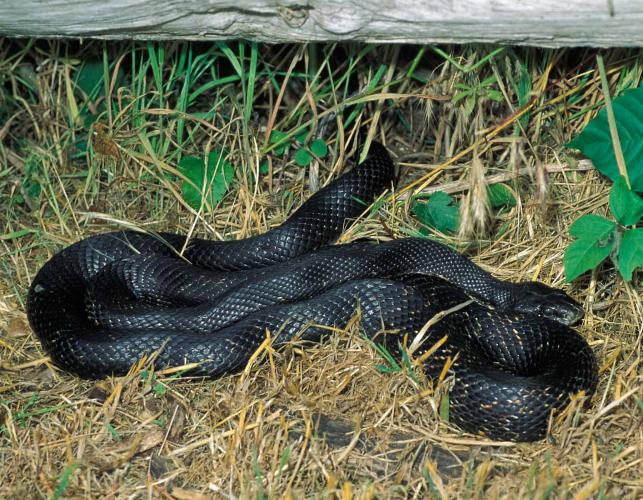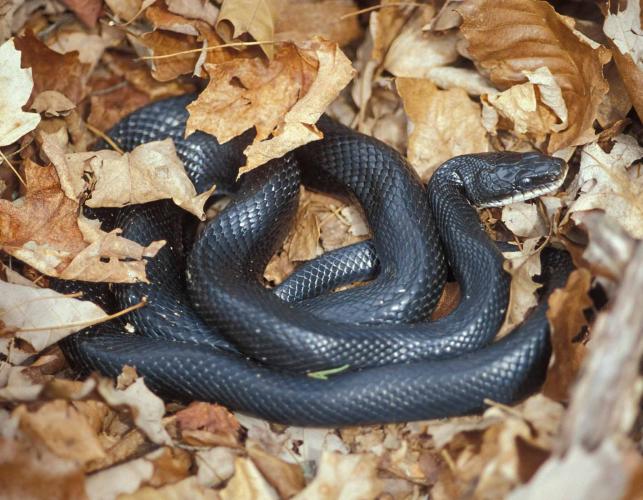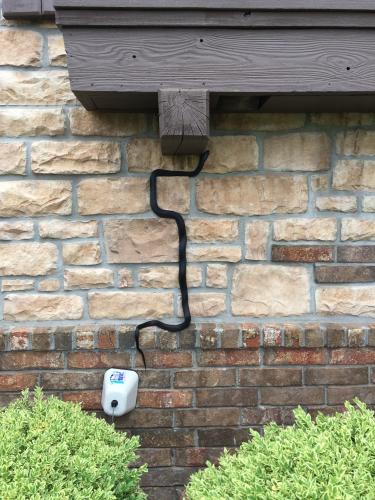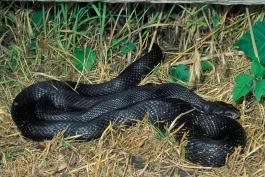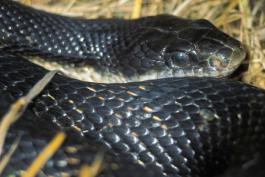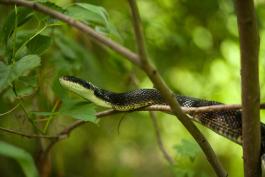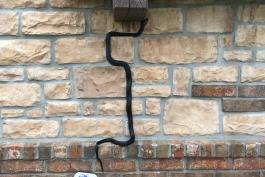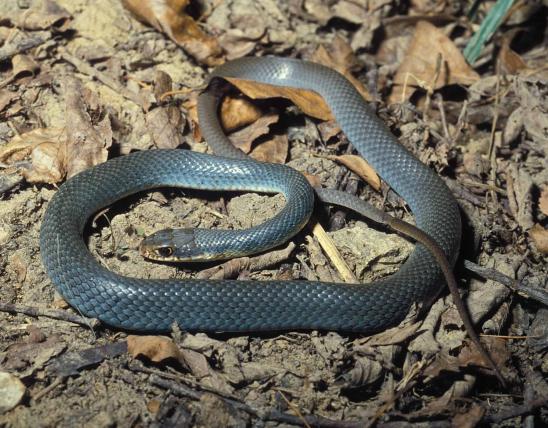
Often called the "black snake," the western ratsnake is one of our state's largest and most familiar snakes. The back is generally shiny black, but some individuals show dark brown or black blotches (especially young adults and specimens in southeastern Missouri). The skin showing between the scales along the sides may be red. The upper lip, chin, and underside of the neck are usually white. The belly is white; the fore part of the belly may be checkered with black, and the hind part of the belly may be mottled with gray, brown, and white or yellow.
Young are gray or tan, with distinct dark brown or black blotches on the back and sides; a black band passes between the eyes and angles down toward the mouth. After a year or two of growth, the color normally changes to a more uniform black.
Ratsnakes are harmless to people but will exhibit defensive behaviors if they feel threatened. When alarmed, ratsnakes may vibrate their tails. When cornered or captured, ratsnakes will bite in self-defense and release a pungent, unpleasant-smelling musk from glands at the base of the tail.
Similar species: Scientists used to recognize multiple subspecies of ratsnake (P. obsoletus), but today this group is considered as only three, full species, including the gray ratsnake, described below, and the eastern ratsnake (P. alleghaniensis), which does not occur in Missouri.
- The closely related gray ratsnake (P. spiloides) occurs east of the Mississippi River but has been reported in southeast Missouri. It is likely that the population in southeast Missouri is composed of hybrids of western and gray ratsnakes. The gray ratsnake's adult coloration can resemble the juvenile pattern of western ratsnakes: gray with dark blotches on the back and sides, with a dark band passing through the eyes and angling down toward the mouth.
- The Great Plains ratsnake is the western ratsnake's other closest relative in Missouri, but only the blotched juveniles of western ratsnakes could be confused with the Great Plains ratsnake.
Adult length: 42 to 72 inches (3½ to 6 feet); occasionally to 86 inches (more than 7 feet).

Statewide. This species may intergrade (hybridize) with the gray ratsnake (Pantherophis spiloides) in the southeastern corner.
Habitat and Conservation
The active season is from early April through October. In spring, early summer, and autumn, they hunt in the daytime; in hot weather, they are nocturnal.
Western ratsnakes are principally a woodland and forest species, preferring rocky, wooded hillsides or sections of woods along streams and rivers. They take shelter in brush piles, hollow trees, farm buildings, and old houses where mice are plenty.
They are excellent climbers and often bask in trees.
They can enter human-built structures that are not sealed sufficiently to exclude them; thus they may also be found along beams in barns and attics and between walls of homes.
They overwinter in mammal burrows, rock outcrops, caves, old rock quarries, old stone wells and cisterns, the foundations of buildings, rotted tree stumps, hollow trees, and similar places.
Food
Western ratsnakes eat a variety of rodents, small rabbits, bats, bird eggs, small birds, and occasionally lizards. They kill prey by constriction, but they simply swallow smaller prey. They are excellent climbers and often climb trees to raid bird nests (including bird boxes) for eggs and young. Young western ratsnakes eat frogs, lizards, and insects.
Status
Common and frequently seen around homes and buildings.
Harmless to people; nonvenomous.
Widely considered beneficial, as it destroys many rodent pests, especially in agricultural settings. See Human Connections.
Life Cycle
This species is active in early April through October. Courtship and mating is usually in spring but also occurs in summer and fall. Eggs, usually 4–40, are laid in June or early July in rotten stumps or logs, tree holes, sawdust piles, or mulch piles, or under rocks. Eggs hatch in autumn after incubating 42–84 days. Females become sexually mature in four years, males in three. Lifespan can exceed 20 years.
Human Connections
Only someone who has dealt with a mouse or rat problem can truly appreciate this natural, nonvenomous hunter of rodents. Rodents cause damage to crops and stored grain. Ratsnakes are a valuable, natural rodent control; they reduce rodent populations without the use of deadly poisons that can inadvertently harm pets or even people. Their benefits far outweigh the occasional theft of a few hens' eggs or baby chickens.
This species was long known as the black rat snake, and many know it simply as "black snake." Recent research has led scientists to reclassify this species in relation to its relatives, so its name has changed accordingly. Herpetologists, like ornithologists, carefully apply common names that correspond exactly to the scientific names. When scientific names change, the common names usually change, too.
Ecosystem Connections
As a predator, this snake helps keep populations of other animals, especially rodents, in check.
Although it can defend itself by trying to bite, by vibrating its tail ominously, and by smearing a stinky musk on attackers, this snake often becomes food for hawks and other predators. The defenseless eggs and the juveniles are especially vulnerable to predation by raccoons, skunks, hawks, and more.
